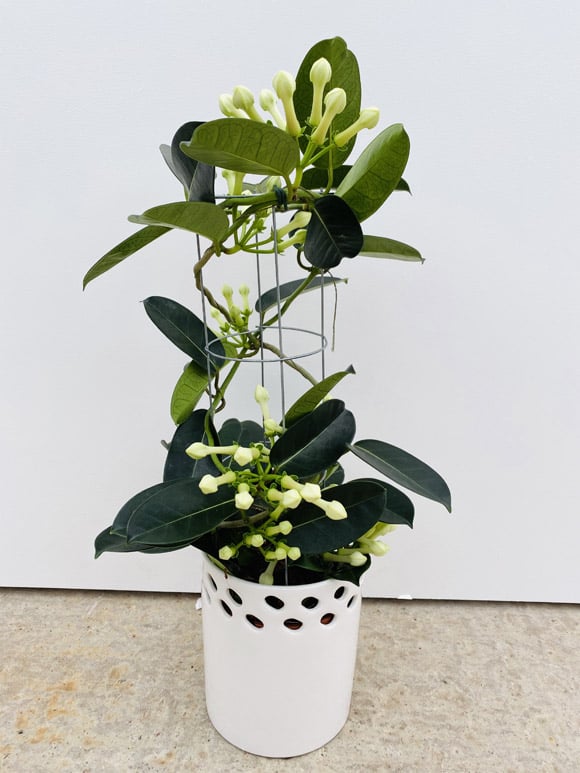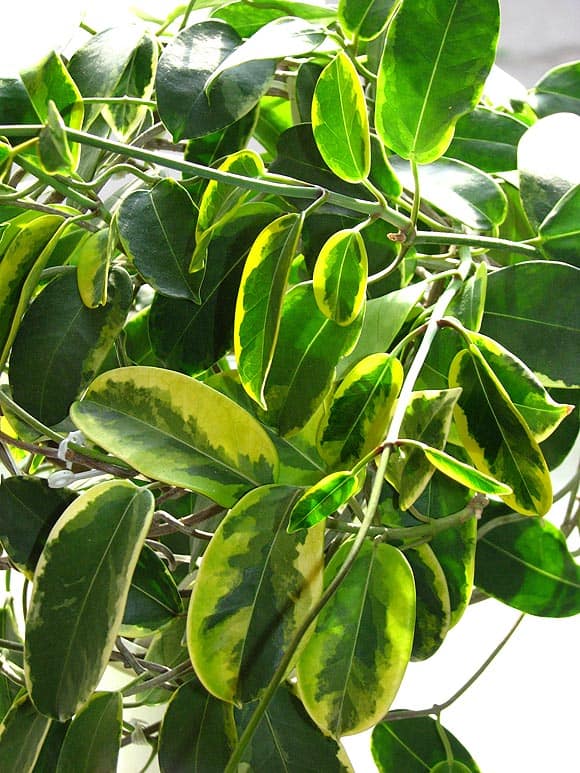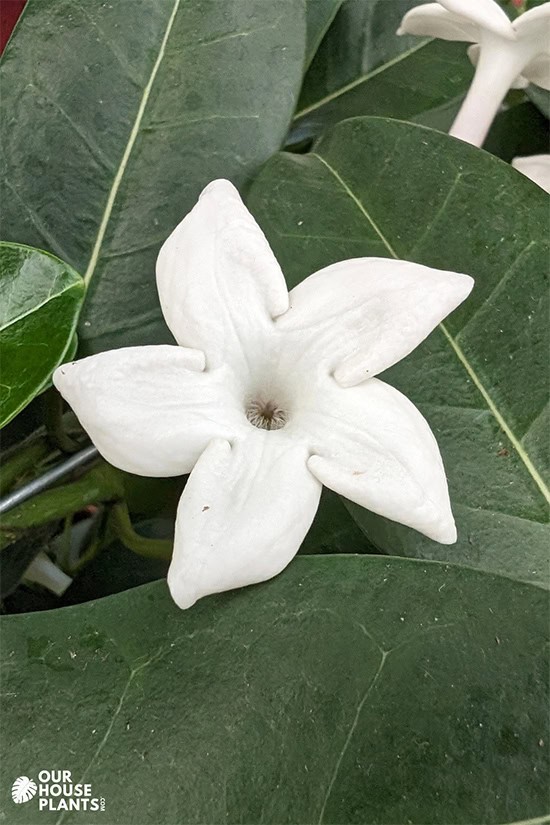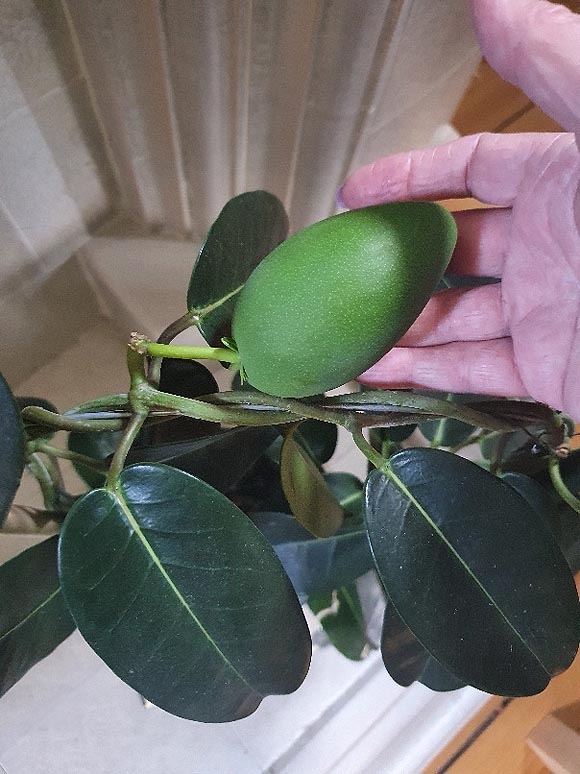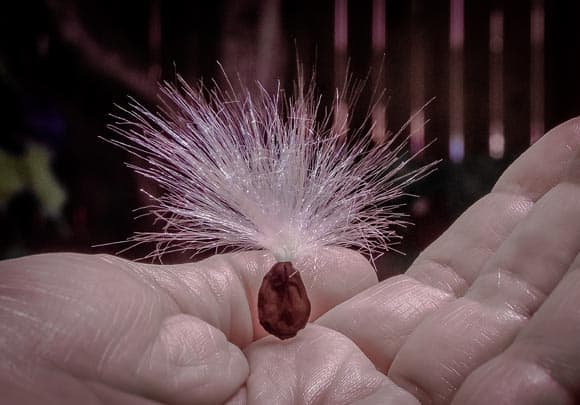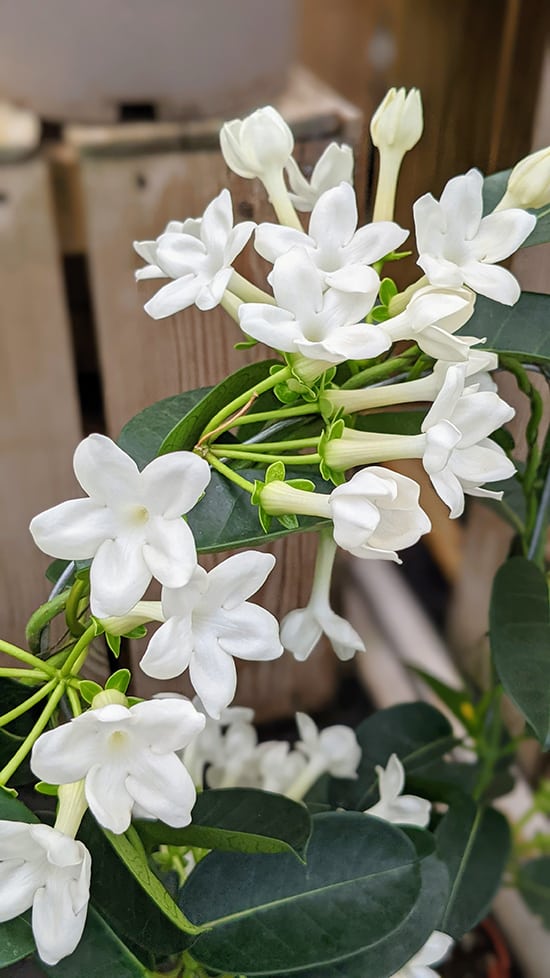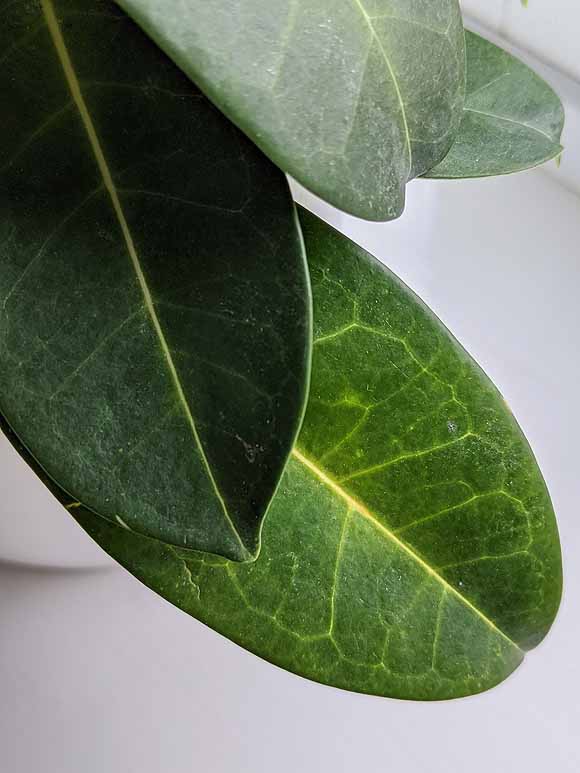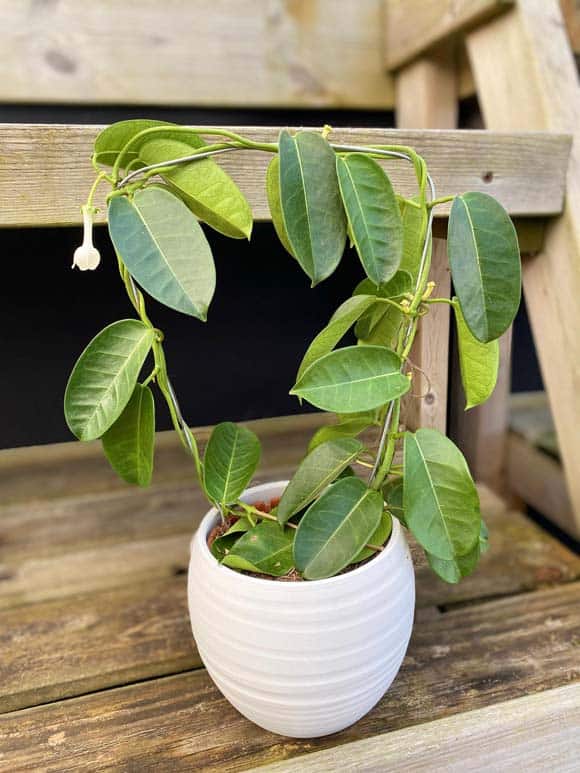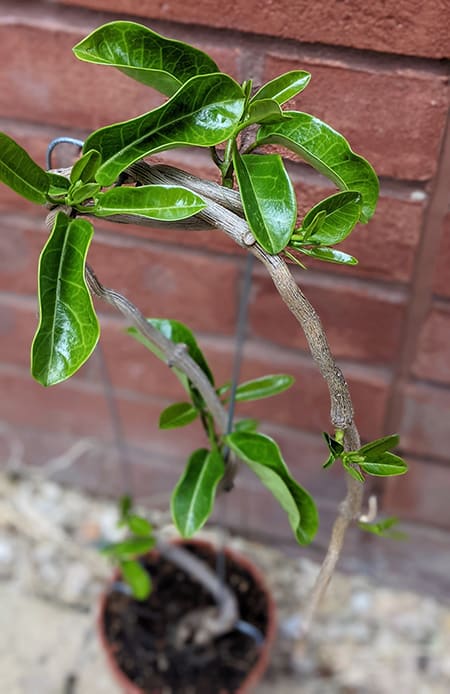Stephanotis floribunda or the Madagascar Jasmine, is a houseplant that's commonly known for its intensely scented pure white flowers. The scent can easily fill a room and the show will last for up to a month before blooming finishes.
The fun doesn't stop there though, these are fairly straightforward indoor plants to keep going and get reblooming again in the future. While waiting for that to happen, they'll give you a strong structural look (if you train it to grow that way) wrapping around a support with tough vines that hold attractive medium-sized dark green oval leaves.
A Stephanotis floribunda plant in a white pot growing around a supporting wire
Stephanotis flowers smell very similar to Star Jasmine, they resemble one another too and the common name of Madagascar Jasmine even sounds similar. You'd be forgiven for thinking the two plants are closely related. They're not.
While the flowers are similar, side by side the plants look totally different. Star Jasmine is more compact and has many smaller leaves with more fragile stems. Stephanotis on the other hand is bigger in every way including flower size. The tougher and bigger blooms account for their popularity of forming part of a bridal wreath.
Is this an outdoor plant?
Many people will grow Stephanotis as an outdoor plant all year round. If you live in a temperate region, then it can be done. But given the right conditions, you can grow your Madagascar Jasmine indoors for years.
Grown as a houseplant you'll find it's pretty hungry and thirsty but over the years I've found it quite accommodating even if it's neglected the ideal growing situations aren't met constantly ;-).
That has come at the expense of consistent repeat flowering, which needs a little more dedication to care. But if you're attentive you can definitely get this plant to rebloom and shortly I'll be telling you how.
There are typically two varieties of Stephanotis sold as houseplants. The all-green variety, is without doubt, the most common. It's handsome and reliable and for most people they're happy to stop there. Although if you're itching for something different then you can go hunting for the variegated version - pictured below.
Photo by Andrey Korzun of the rare Stephanotis floribunda 'variegata'
Stephanotis floribunda 'variegata' is much harder to find and I would imagine you can expect to pay more for one if you really love it. I find the all-green variety is fairly uncommon as it is, with only a handful of shops stocking it and then only for a few months each year.
Can you help out?
Lots of people ask where they can buy these plants, in particular the variegated type.
If you've any good suggestions where you can pick one up from, let us know in the comments as this would be a huge help to fellow readers.
You should be able to find Stephanotis for sale in most garden centres and nurseries. It's certainly less common in more generic places like superstores. This is a fairly expensive plant for its size and the shortish flowering period can turn people away.
I'd encourage you to have a second look though. If carefully and neatly grown around a wire hoop or supporting frame (which isn't hard to make yourself if the plant comes without any support), the vines and leaves are good-looking enough, that together they'll stand out and draw eyes even when not in bloom.
Anyway if you're reading this article, the chances are you already have this plant and sitting there with your hand eagerly in the air asking "Please Tom, how do I look after a stephanotis plant?", so let's move forward and get that answered for you now.

Hi, I'm Tom!
If you're like me and enjoy the challenge of growing houseplants and getting them to thrive, then Ourhouseplants can help. This website shares my knowledge and years of growing plants and provides (hopefully) helpful advice on properly caring for your indoor plant friends.
Good light levels are needed for the long-term health of your plant and absolutely essential if you want it to reflower in the future. Stephanotis is not the plant for a long-term relationship with a shady or low light location.
By all means, show it off on a coffee table in a dimly lit room whilst it's flowering, but once it's over move it back to a brighter space.
Stephanotis is not the plant for a long-term relationship with a shady or low light location
The leaves can easily scorch in hot intense sunlight that you get from just before mid-day. I'd recommend avoiding south facing windows unless there is some kind of shielding to reduce the light intensity coming through the window.
Does stephanotis like full sun? Yes, sort of. What you're looking for is a bright location, perhaps with some early morning or late afternoon sunlight, but avoiding the intense sun (and definitely avoid low light spots).
In winter, when your plant's dormant, let the soil dry out almost fully before re watering it. It's very easy to end up with masses of yellowing leaves from overwatering at this time of the year, so go careful.
Three Simple Watering Rules
1. Mostly moist soil from spring to autumn.
2.Almost dry soil in winter.
3. Never sodden or completely dried out at any time.
In Spring and Summer when things warm up and get brighter, up your watering game.
They'll need a good drink a few times a week when the temperature is high, less of course if the light levels are below what we've recommended above.
Many houseplants follow these rules and it's true for Stephanotis too. You want moist/damp soil for the majority of the growing season. Not sodden and not dried out. Avoid those extremes as almost all problems you can experience with these plants come from watering mistakes.
The waxy leaves are fairly thick, tough and have an almost succulent feel. In general, plants with this type of leaf structure tend to be somewhat impervious to humidity levels, being able to cope with any level found in a typical home.
So I was surprised to keep reading and hearing people saying these plants needed higher levels of humidity and constant misting to do well. That's not been my personal experience and I've tested it both ways.
The leaves seem fine and look good no matter if the humidity levels were high or average. I suspect they'll tolerate average humidity and still like you, but if given high humidity levels they'll change that like to love.
I would however caution trying to grow them in excessively dry air (near open fires or above radiations). Otherwise, it seems good with whatever you can give it.
A large number of common houseplants will put up with sporadic feeding. Some will even cope perfectly well with long periods of no feed at all. But I've found Stephanotis will quickly look chlorotic and start to develop yellowing lines and hues on the leaves if you neglect to feed it for long periods.
In some ways, this is an excellent tell tale sign that it wants feeding, as many plants won't give such obvious hints. Try to prevent it by feeding your plant at least once a month during the growing seasons. No feed is needed in winter.
These houseplants will need feeding at least occasionally if you want them to grow beautiful blooms like these.
They'll grow perfectly well in a broad range of average home temperatures. If you're happy then your plant will be too. Being a bit more precise, you're looking at a broad range between 16°C (57°F) - 23°C (73°F) plus.
Temperature Tip
If you can't meet the temperature range over winter then your plant should still be fine, but the number of flowers you'll get will likely be fewer or even nonexistent.
During winter they need to rest for a few months, and this means the temperature needs to be cooler. Aim for between 10°C (50°F) - 16°C (60°F).
This isn't a normal temperature in most living areas so you may have to think about moving your plant to a rarely heated room. Avoid chilly and draughty spots though. Stephanotis is not frost hardy and this type of chilly climate must be avoided. Otherwise, look what happens.
Although the plant will grow a fairly large root network, the small white roots are very fragile and will break apart even with gentle handling. Repeat flowering also requires it to be a little pot bound too. As a result, this houseplant is not keen on frequent repotting and you won't have to do it more than every two or three years.
When you decide to mix things up, either leave it in the same container and just knock off some of the old soil and replace with fresh or move it into a container one size bigger. They honestly don't need a large pot to do well.
The soil mix needs to be good and ideally enhanced with some kind of nutrient boost. It's not essential as you can always top up the plant with feed down the road, but you'll definitely need a good quality potting mix. If what you have is too heavy and dense, add in some grit or perlite to help with drainage to help keep the soil aerated.
There are only a handful of houseplants that can be propagated by seed and Stephanotis is one of them. Although patience is needed as you'll be playing the long game because the process can take 12 months to complete.
After flowering, if you're lucky, the plant may start to produce one or two seed pods which will steadily grow to look almost like an unripe avocado, see below.
Photo submitted by one of our readers, Julie, showing the ripening Stephanotis seed pod
At this stage, you can remove it from the plant and then you need to wait. Ideally, put it somewhere hot with direct sunshine. Either on a windowsill or outside in your flower beds. The sun and heat will bake the pods and finish off the forming of the seeds inside.
After several months the pod will dry out and eventually split open to reveal the seeds. At this point, you can fully open the pod and plant up the seeds inside. Each one will have a fluffy tuff of hair which out in the wild will catch on the wind and parachute to new locations for germination.
Photo by Etan J. Tal of a Stephanotis seed with "parachute"
Sow some seeds by laying them on top of a pot/tray filled with compost and then lightly cover the seeds. They shouldn't be too deep. They need to be kept moist and warm until they germinate. So the best time to do this is late Spring and Summer when temperatures will be warm.
Once large enough to handle you can separate the plants and grow them individually.
You can also try and create new plants from stem cuttings. Using new stems no older than a year old (it won't work very well using old mature stems) with one or two leaves in place, plant up into pots with fresh compost and keep moist and warm.
I'd recommend using a rooting hormone too, but even then, stem cuttings don't have a huge success rate (almost all my attempts have failed!).
Stephanotis floribunda is normally fast-growing when grown outdoors. An outdoor plant will have multiple stems all growing and producing new leaves so the speed of growth will seem faster. Indoors you might only have one main vine and the light levels are unlikely to be as good. Indoors I get moderate growth at best.
Growing Tip 1
Flowers will only form on new growth. So by all means prune your plant when the new growth starts to take over, but leave some alone otherwise you won't get new blooms that year.
A great advantage with vining plants is that you're in control. You set the look, the height and spread of your plant.
If left alone, a single vine will grow on and on over many years up to 6 m (20 ft). However this would be a scraggy and out of control houseplant. Instead, it's much better to let it grow and as it does, wind the stems around a hoop or support frame.
Growing Tip 2
The stems are tough and the stems climb vigorously, but the bulk of the plant can get top-heavy and be quite unstable without support. Make sure you're keeping things in check as it's growing.
The stems harden up and become much less flexible over time so you need to "train" your Stephanotis vines as they're growing and not do it retrospectively.
A mature plant will generally flower yearly if they're well looked after.
You will also need to provide a winter rest. If you just grow your plant in a standard way and leave it in place all year round you either won't get any buds at all, or just a small number.
The fragrant flowers normally start to appear between late Spring until late Summer and start off as long buds around 3 cm long that gradually open and become tubular star-shaped.
With their pure white flowers and sweet scent, it's no wonder they're used in bridal bouquets.
Highly scented initially, each one will last several days, longer in cooler spots, before gradually starting to fade and go yellow. The heavy deep fragrance starts to sour as the yellowing increases. Some people really dislike the scent at this stage (me included!) so you can pick off the dying flowers at this point if needed.
The plant produces a high number of buds and they don't all open at once. So although each individual flower is fairly fleeting they'll keep opening over a longer period meaning you can enjoy them for up to a month or more. Pick them off when blooming is finished, or leave them if you want to see if a seed pod will form.
No toxic effects have been reported as a result of people or pets eating parts of this houseplant. However as always, we recommend is that pets and children should be discouraged from playing with indoor plants.
Some houseplants need to slow down, recover and ready themselves for the following growing season, Stephanotis fits into this list and will be really grateful if you let it rest. If you do, then there is a much better chance of repeat blooming.
How long should the rest period be?
After a few months of resting, it can go back to where it was growing before. Once spring fully arrives usual activities should gradually start resume and the normal care instructions should be followed.
To provide the winter rest, all you need to do is move it to a cool room which achieves temperatures of around 10°C (50°F) - 16°C (60°F).
Stop feeding completely. Less light and water are also helpful, although it will still need some over this resting period.
If you can meet the basic care requirements, your Stephanotis won't make a fuss and will happily blend into the background. This can make it easy to overlook and the plant will quickly get covered in dust.
While not harmful, it can slow down growth and encourage pests, so make sure you regularly give it a clean. Check out our how to clean houseplants article if you want some pointers for this.
Medium to Bright Light Good light is essential for your plant to rebloom. Harsh midday sun can be damaging. Avoid this, but sun in the morning and late afternoon is fine.
Moderate Watering Bright light and warm temperatures will mean you can expect to water once or perhaps twice a week. Much less is needed in winter, or when temperatures are generally cooler. Well-drained soils will help to prevent waterlogging.
Temperature Goldilocks temperatures are needed - Warm rooms between 16°C (57°F) - 23°C (73°F). No excessive heat or cold. Cooler temperatures are needed in the winter months whilst the plant is resting.
Feeding Try to feed once every month. None required in winter.
Madagascar Jasmine not flowering
How do you get the stephanotis to bloom? The best chance it has of blooming is by providing it with a winter rest period and then when the growing season starts back up, make sure you're putting it in a warm space with plenty of light.
New plants will take several years before they produce their first set of blooms. Plants which are growing in very small pots or rarely fed will also be less likely to flower.
Why are the flowers on my Stephanotis falling off?
Being rough with it or rapid changes to its environment can annoy your plant to such an extent it'll throw its unopened buds on the floor in disgust. No, really! They're normally tolerant of change to a degree, but try to keep it to the minimum.
Care needs to be by the book over this period too. Overwatering or underwatering and excessively dry air can easily trigger buds to fall, so follow all the rules above and you should be good.
Why are the leaves on my Stephanotis turning yellow?
Unfortunately several things can cause this, it's also difficult to know easily what the problem is as the plant will really keep hold of all its leaves and is reluctant to let them go.
You need to evaluate the recent care you've provided and try to work out what's happened. Time to get your detective hat on and let's study the clues. A list of things that can cause yellowing (in most likely order) is below.
Yellowing leaves on a Stephanotis houseplant.
My stephanotis is dying, help!
Although this can be a fussy houseplant it rarely gives up and dies all of a sudden. Poor treatment normally causes a slow gradual decline in health. So if your plant suddenly looks like the one in the photo below the cause is likely one of two causes.
Wilting leaves and a sparse looking Stephanotis.
All the leaves have fallen off. Should I throw it away?
This is a strange one. I've found (for a reason I can't pinpoint) one year my plant lost all of it's leaves and all I was left with, were gray woody stems wrapped around the wire hoop. I moved it outside in early Spring and just left it, thinking it was destined for the compost bin.
A month or so later I was tidying up my garden and was about to empty the container it was in and clean it up for future use when I saw new leaf buds forming.
Although it was a bit of a shock, I was naturally pleased and left it outside all summer. Before long, the leaves had regrown.
I thought this plant was finished for good after it lost all it's leaves one Winter, but the following Spring it came back to life.
By the end of the year it was back to full health. I'm not expecting flowers this Winter, but perhaps next year. I'll update this if that happens.
Although I do enjoy scented houseplants from time to time, I'm not their biggest fan. Controversial I know, but let me explain. I find many houseplants have a wonderful and intoxicating scent (clearly the reason they've become popular indoor plants in the first place, makes sense right?) but the fragrance often changes over the day.
Sometimes you get them at the peak of their brilliance and they smell great. Then comes the evening and it's replaced with a smell that's, putting it politely, not good. So space in my home for highly scented plants is strictly limited and on a permitted quota only.
I always found Stephanotis and Star Jasmine flowers to be very similar smelling, so as Jasmine was more common and cheaper around here, it won out. Anyone who has owned one of these, knows they get pretty overgrown and messy if not well looked after.
I have a lot of houseplants so I don't have all that much time to fuss them. Low maintenance is my mantra. So the more trained and controlled Stephanotis naturally had appeal over the Star Jasmine, and a few years ago I decided to give it a go.
Yes, the scent is a drawback for me (the main reason people buy this houseplant I know, but I've explained my issue with it above), but the shape and growth habit is a huge plus. It's easy to keep compact and in control. If you follow the basic care instructions too, it keeps to itself until winter without much hassle.
Maybe I don't love it for the main reason many of you do, but I love having it around all the same.
(Article / Gallery) Photo credit of Stephanotis floribunda 'variegata' - Andrey Korzun
(Gallery) Photo credit of Stephanotis Floribunda in full bloom - randreu
(Article / Gallery) Photo credit of Photo of a Stephanotis seed - Etan J. Tal
